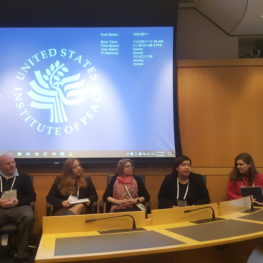Last February 1, 2018, I had the opportunity to join a panel of formidable Humanitarian Aid workers during the 2018 NEXUS USA Summit. The session entitled “Giving More Directly After Disasters” talks about how we frequently hear about big disaster i.e, Katrina, Haiti, Sandy, Nepal, Maria, relief efforts that don’t work and the generosity of donors not fully realized by survivors. I joined Marcie Roth from Inclusive Emergency Management Strategies, Aryah Somers Landsberger from the Grantmakers Concerned with Immigrants and Refugees, Emily Troutman, Journalist from Aid.Workers, and Ben Smilowitz from SmartResponse.org and Disaster Accountability Project, in answering the questions:
- What happens to hundreds of millions of dollars that are raised?
- Which groups fare worse and what happens to local nonprofits and civil society organizations
- What are the lessons learned from past humanitarian experiences that will help donors make more informed decisions and give more directly?

The panel requested me to deliver the opening statement and below is an excerpt of what I shared during the session:
The context of the Disaster Response
The Philippines is a country of 7,107 islands. It is located in south-east Asia, just above the equator. It rests in the pacific’s earthquake and volcano ring of fire. It is also a gateway to typhoons (or what is called hurricanes here in the US). It has the warmest ocean temperature in the world and for typhoons to form it needs above 28 degrees Celsius at 82 degrees Fahrenheit. The Philipines in the year 2013 was a year that the country had to deal with the biggest and deadliest natural disasters. It also proved to be a pivotal year for many of the local civil society organizations in the Philippines, including my organization called the Philippine Center for Civic Education and Democracy.
The Philippine Center for Civic Education and Democracy is a non-profit organization dedicated to strengthening civic education as a means to a more meaningful participation in the democratic life. PCCED believes that our common vision as a people is to make democracy work out of love of country. That vision guides us in our work with teachers, youth leaders, local authorities, and the civil society groups.
The story to put in perspective on how an organization working on promoting civic participation got involved in humanitarian work began when I was managing a project that promotes civic participation in the various decision-making processes of the local governments and sectors in the Philippines. From our Manila HQ, I received a message from our staff that a 7.2 magnitude earthquake has occurred in the Province of Bohol (our project area). To make sense of the magnitude it is as strong as 32 times atomic bomb dropped in Hiroshima, and it generated more than 4,000 aftershocks with 200 deaths, 797 injured and displaced tens of thousands of residents.
3 weeks after, the strongest and deadliest Super Typhoon Haiyan, took place in the neighboring Province, Leyte. Super Typhoon occurred with storm surges reaching 23 ft and as high as 16 ft. It affected 12. 9 million people or 13 % of the Philippines’ total population. It claimed 4,460 lives and left 1.9 million people homeless. Instinctively, as a development worker, and just like the many other Filipinos, I’ve reached out to our existing partners and donors to inform them about the situation and appealed for help.
We’ve got noticed and we were heard – thanks to the media coverage the Philippines was instantly in every news headline -tv, print, and social media. We’ve received a small funding (close to 1 million dollars) relative to the International humanitarian organizations, but big for a small non-profit organization from private individuals, business groups and corporation, foreign governments, religious groups with a wide array of interests and priorities.
3 Key Points that I highlighted in my talk
1. What did the donors want?
There were 3 things that the donor wanted: Deliver! Deliver! Deliver!
- Deliver all possible aid to the most number of affected population (quantity)
- Deliver the targets in the least amount of time (efficiency).
- Deliver the targets to the highest standard (quality)
What were the targets?
- Shelter
- Food security
- Wash,
- Nutrition
- Education)
The donors also wanted me (as a Project Manager) to sign my initials in every plywood and lumber that will be delivered to the affected population
2. What my organization (like the rest of the world) initially thought about taking responsibility for the donation?
I can vividly remember how as a senior manager of the organization at that time, I was called by the board to explain to them the merits of accepting the fund. Mixed feelings were expressed over the matter. I gained little support from my colleagues in the senior management team. The apprehension expressed were based on our organization’s reality:
- Limited Resources: We have limited resources to demonstrate our ability to manage a big portfolio or to contribute to the cost-sharing of implementation
- Limited capacity: We don’t have sufficient staff because, as non-profits, we operate on a per-project basis. The team that I was leading at that time is comprised of 3 people (including me), all women. We also don’t have sufficient technical capacity on humanitarian aid.
- Limited experience: We don’t have a track record for doing humanitarian work.
Like what the rest of the world thinks, humanitarian work is a very big sphere for a small organization like ours to squeeze in.
3. How can a daunting task be transformed into action?
As we try to strike a balance between aspiration and reality, my team and I responded to demands and limitations:
- Limited Resources:
- We can increase the stake of the community. We never wanted it to be a dole-out so for the shelter program, the affected population was requested to:
- Identify materials that can be salvaged from their old damaged houses
- Prepare the land/site where their new shelter will be built
- Identify a representative of the family to assist in the hauling
- Contribute labor in constructing their housing;
- We engaged the local government units for technical assistance by requesting for a program of work from the municipal engineering office for the design of the shelter;
- We engaged the municipal social welfare and development in identifying and prioritizing the affected population;
- We requested the use of big trucks, equipment and other counterparts from the local government for items not allowed by the funder
- We can increase the stake of the community. We never wanted it to be a dole-out so for the shelter program, the affected population was requested to:
- Limited Capacity:
- We created a pool of volunteers by partnering with the universities;
- (Operating on a very limited operational cost) We expanded our team from 3 to 9 except that we did not pay salaries that are competitive with what international organizations are paying their staff, but we knew that those who signed up for us are dedicated workers
- Limited experience: Says who?
- Sure we have not branded ourselves as humanitarian workers, but we have been doing community projects.
- We know our community, they are our neighbors, our participants, we serve them, we engage with them.
The results of our work
- Delivering our targets to the most number affected the population, in the most efficient time, with the highest quality.
- Facilitating the growth and expansion of our organization, as we tried to address the gaps in our capacity, resources, and experiences
- Standing by our mission and vision of transforming the communities into schools of citizenship; the tri-partite governance among civil society organizations, government, and business community did not only result to efficiently and effectively delivering the help needed by the affected population, but also creating a sense of civic community in the disaster-affected area
Post Disaster
We’ve run 3 more cycles of humanitarian work, and recently before I left the organization to do my Atlas Corps fellowship at Heartland Alliance International in Chicago, I’ve worked on developing new programs and securing funding for projects that integrate civic participation in disaster risk reduction and management.
This gives a chance to men, women, youth, elderly, leaders, persons with disabilities, and every member of the community to take part in mitigating risks and impacts of natural hazards.
I’ve also actively lead a consortium alongside directors and leaders of 3 other civil society organizations that focus on initiatives aimed at strengthening the capacity of local organizations.
Lessons Learned:
- Never forget that the capacity, resources, and experiences are deeply-rooted and in times of disaster, deeply rooted knowledge, skills, and values work at its best, and we can do it more efficiently, in big quantity and in the highest quality.
- Veer away from the seeming divide between the humanitarian work and development work which many civil society organizations are focused on because at the heart of civil society organization’s work is the humanitarian work



